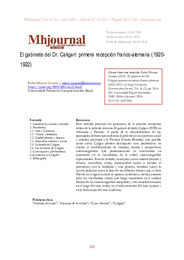Por favor, use este identificador para citar o enlazar este ítem:
https://hdl.handle.net/11000/37375Registro completo de metadatos
| Campo DC | Valor | Lengua/Idioma |
|---|---|---|
| dc.contributor.author | Morato Zanatto, Rafael | - |
| dc.contributor.other | Departamentos de la UMH::Ciencias Sociales y Humanas | es_ES |
| dc.date.accessioned | 2025-09-12T11:51:15Z | - |
| dc.date.available | 2025-09-12T11:51:15Z | - |
| dc.date.created | 2025 | - |
| dc.identifier.citation | MHJournal Vol. 16(2) | Año 2025, Artículo nº12(267) | es_ES |
| dc.identifier.issn | 1989-8681 | - |
| dc.identifier.uri | https://hdl.handle.net/11000/37375 | - |
| dc.description.abstract | Este artículo presenta un panorama de la primera recepción crítica de la película alemana El gabinete del doctor Caligari (1920) en Alemania y Francia. A partir de la reconstrucción de los principales debates que rodearon la película en un contexto social y artístico posterior a la Primera Guerra Mundial, será posible notar cómo Caligari plantea discusiones muy productivas en cuanto al establecimiento de criterios, teorías y perspectivas cinematográficas que paulatinamente se convertirán en constantes en el vocabulario de la crítica cinematográfica especializada. En este sentido, conceptos como unidad plástica y rítmica, atmósfera, estilo, expresividad social o incluso el parentesco con la tradición y con géneros literarios como la novela policíaca serán la base de un esfuerzo teórico que, si bien fluctúa en el rigor con que se operan, condensa o incluso anuncia todo un vocabulario crítico que luego cristalizará en el análisis fílmico de las cinematografías nacionales y sus transformacionesen el auge del cine mudo, en el advenimiento del cine sonoro y en la formación del cine moderno | es_ES |
| dc.description.abstract | This article presents an overview of the first critical reception of the German film The Cabinet of Dr. Caligari (1920) in Germany and France. Starting from the reconstruction of the main debates surrounding the film in a social and artistic context after World War I, it will be possible to note how the film raises very productive discussions regarding the establishment of criteria, theories and cinematographic perspectives that will gradually become constant in the vocabulary of specialized film criticism. In this sense, concepts such as plastic and rhythmic unity, atmosphere, style, social expressiveness, or even the kinship with tradition and with literary genres such as the detective novel will be the basis of a theoretical effort that, although it fluctuates in the rigor with which it is operated, condenses or even announces an entire critical vocabulary that will later crystallize in film analysis of national cinematographies and their transformations in the rise of silent films, in the advent of sound films and in the formation of modern cinema | es_ES |
| dc.format | application/pdf | es_ES |
| dc.format.extent | 17 | es_ES |
| dc.language.iso | spa | es_ES |
| dc.publisher | Universidad Miguel Hernández de Elche | es_ES |
| dc.rights | info:eu-repo/semantics/openAccess | es_ES |
| dc.rights.uri | http://creativecommons.org/licenses/by-nc-nd/4.0/ | * |
| dc.subject | History of film | es_ES |
| dc.subject | History of Criticism | es_ES |
| dc.subject | German Cinema | es_ES |
| dc.subject | Caligari | es_ES |
| dc.subject | Historia del cine | es_ES |
| dc.subject | Historia de la crítica | es_ES |
| dc.subject | Cine Alemán | es_ES |
| dc.subject | Caligari | es_ES |
| dc.subject.other | CDU::3 - Ciencias sociales | es_ES |
| dc.title | El gabinete del Dr. Caligari: primera recepción franco-alemana (1920-1922) | es_ES |
| dc.title.alternative | The Cabinet of Dr. Caligari: First Franco-German Reception (1920-1922) | es_ES |
| dc.type | info:eu-repo/semantics/article | es_ES |
| dc.relation.publisherversion | https://doi.org/10.21134/we872963 | es_ES |

Ver/Abrir:
12-3201-El+gabinete+del+Dr.+Caligari_+primera+recepción+franco-alemana+(1920-1922)REV.pdf
309,02 kB
Adobe PDF
Compartir:
 La licencia se describe como: Atribución-NonComercial-NoDerivada 4.0 Internacional.
La licencia se describe como: Atribución-NonComercial-NoDerivada 4.0 Internacional.
.png)